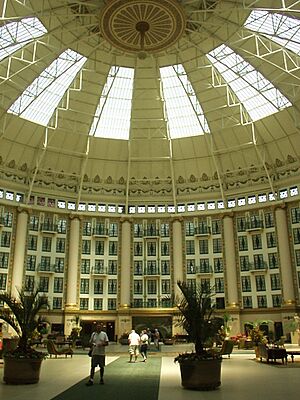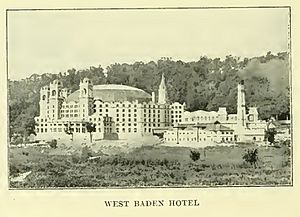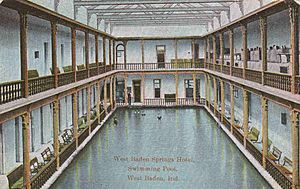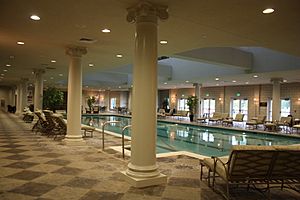West Baden Springs Hotel facts for kids
|
West Baden Springs Hotel
|
|

Dome of the hotel
|
|
| Location | West of State Road 56, West Baden Springs, Indiana |
|---|---|
| Area | 100 acres (40 ha) |
| Built | 1901 |
| Architect | Harrison Albright; Oliver J. Westcott |
| NRHP reference No. | 74000016 |
Quick facts for kids Significant dates |
|
| Added to NRHP | June 27, 1974 |
| Designated NHL | February 27, 1987 |
The West Baden Springs Hotel is a famous historic hotel in West Baden Springs, Indiana. It is part of the French Lick Resort Casino. The hotel is well-known for its huge dome, which is 200-foot (61 m) wide. This dome covers the hotel's main open area, called an atrium.
For a long time, the hotel had the largest free-standing dome in the United States. From 1902 to 1913, it was even the largest dome in the world. The hotel was added to the National Register of Historic Places in 1974. It became a National Historic Landmark in 1987. It is also recognized as a National Historic Civil Engineering Landmark. The hotel is part of the National Trust for Historic Preservation's Historic Hotels of America program.
Contents
The Hotel's Beginnings
Long ago, animals like bears and deer visited a salt lick near where the West Baden Springs Hotel now stands. This area was along the Buffalo Trace in southern Indiana. Native Americans also used the land for hunting. Later, French traders and settlers arrived, and the place became known as French Lick.
In 1778, George Rogers Clark camped near the salt licks and mineral springs in Orange County. These springs later became the towns of French Lick and West Baden Springs. The state government thought about mining salt there. But they found there wasn't enough salt for a big mining operation. So, the land was sold around 1832.
A local doctor named William A. Bowles bought the land with the mineral springs. He built a small inn around 1840–45. This inn grew into the French Lick Springs Hotel, a popular health resort.
A New Hotel Idea
In 1846, Dr. Bowles leased his land to John A. Lane, another doctor. Lane agreed to make the French Lick hotel bigger and better. Part of Bowles's land included springs known as Mile Lick, about 1 mile (1.6 km) north of French Lick. This area was often wet and marshy. But Lane saw it as a great spot for a new business. He thought it could even be better than French Lick.
In 1851, Lane bought 770 acres (310 hectares) from Bowles. He built a sawmill and a bridge over Lick Creek. Then, he built a hotel that was even bigger than the French Lick Springs Hotel. This started a rivalry between the two Orange County resorts.
West Baden Springs Hotel History
Around 1852, John Lane opened his new hotel near Mile Lick. He called it the Mile Lick Inn. In 1855, the community was renamed West Baden. This name came from Wiesbaden (or Baden-Baden), a famous spa town in Germany known for its mineral springs. So, Lane changed his hotel's name to the West Baden Inn. By the 1860s, it was known as the West Baden Springs Hotel.
In 1887, the Monon Railroad built a train line to bring guests to the hotels in French Lick and West Baden. The two hotels competed to offer the best services, fun, food, and mineral water. By the late 1800s, guests came from all over the country. They arrived by train to relax and try the mineral water, which people believed could cure many sicknesses.
West Baden sold water from its springs under the name Sprudel Water. Its logo even featured a gnome named Sprudel. French Lick sold Pluto Water, using a red devil as its symbol.
A New Owner and a Fire
In 1888, a group of investors bought the West Baden hotel and 667 acres (270 hectares) of land. One of these investors was Lee Wiley Sinclair. The hotel burned down in 1891, but it was rebuilt. Over the next few years, Sinclair bought out his partners and became the only owner.
Sinclair turned the hotel into a fancy resort. It was called the Carlsbad of America. It had a casino, an opera house, and a covered, oval track for bicycles and ponies. A baseball field in the middle of the track was used by major league teams for spring training. These teams included the Cincinnati Reds, Chicago Cubs, and Pittsburgh Pirates.
On June 14, 1901, the hotel caught fire again. Luckily, no guests were hurt. Sinclair offered to sell the property to Thomas Taggart, who owned the French Lick Springs Hotel. But Taggart refused, saying he would just make his own hotel bigger. Sinclair was very upset. He decided to build a brand new, circular hotel. It would be fireproof and have a huge dome. He wanted to open it within a year.
Most builders thought a 200-foot (61 m) dome was impossible. But Harrison Albright, an architect, designed the building. Oliver Westcott, a bridge engineer, designed the dome's supports. To finish the hotel quickly, 500 workers worked six days a week for 270 days. The new hotel cost $414,000 to build.
The Eighth Wonder
The new hotel opened on September 15, 1902. People loved it! Its official opening was on April 16, 1903. The governor of Indiana, Winfield T. Durbin, and U.S. Senator Charles W. Fairbanks gave speeches. Advertisements called it the Eighth Wonder of the World.
The hotel offered many fun things to do. There was a gambling casino and live theater every night. Guests could also enjoy opera, concerts, movies, bowling, and billiards. Palm trees grew in the huge atrium. Birds flew freely, and guests relaxed on comfy chairs under the 200-foot (61 m) dome. The atrium had a giant fireplace that could hold logs as long as 14 feet (4.3 m).
Outside, guests could swim in a large pool, play on two golf courses, or go horseback riding. There were also baseball games, hiking trails, and a covered, double-decked oval track for bicycling. This track was 1,760 feet (540 m) long, the biggest in the country. For wealthy guests, the hotel even had a bank and a stock brokerage. A trolley took guests from the hotel to nearby French Lick.
The hotel had about 500 rooms across six floors. The ground floor had the lobby, offices, dining area, shops, and meeting rooms. Saunas and mineral baths were on the top floor. Guest rooms were on floors two through five, built in two circles around the atrium. Some rooms looked out onto the atrium, and 40 rooms had balconies. The rooms were small, and most did not have a private bathroom.
Famous Visitors
Many famous people stayed at the West Baden hotel. From the late 1880s, southern Indiana became a favorite spot for the rich and famous. They came to relax, play golf, gamble, eat well, and be entertained. As one author said, "These hotels were the Disney World of their time."
Paul Dresser wrote Indiana's state song, "On the Banks of the Wabash, Far Away", at the hotel. Boxers John L. Sullivan and James J. Corbett trained there. Famous people like Diamond Jim Brady and Al Capone often visited. Politicians like Chicago's mayor, "Big Bill" Thompson, and New York's governor, Al Smith, also stayed there. General John J. Pershing, writer George Ade, and entertainer Eva Tanguay were guests too. Many professional baseball teams, including the Chicago Cubs and St. Louis Cardinals, held spring training in the area.
Hotel Updates
Small updates to the hotel began in 1913. But a fire on February 11, 1917, destroyed the hotel's bottling plant, opera house, bowling alley, and hospital. These had to be rebuilt. Before these fires, the hotel owner, Lee Sinclair, became ill. His daughter, Lillian, and her husband, Charles Rexford, took over running the hotel. When Sinclair died in 1916, the Rexfords managed the hotel.
Charles Rexford did not want big changes, but Lillian decided to do a major renovation. She wanted to give the hotel a Greco-Roman style. Between 1917 and 1919, Italian artists installed a beautiful mosaic tile floor in the atrium. It was made of two million small marble squares. The atrium fireplace was covered with new ceramic tiles. Marble was added to the atrium walls, and the brick columns were painted to look like marble. Outside, a fancy veranda was built. The wooden shelters at the springs were replaced with brick ones. A sunken garden with an angel fountain was also created.
Edward Ballard helped pay for these improvements. He had started working at the hotel's bowling alley. He became rich by running a business that involved gambling in the area. Ballard also owned several traveling circuses. From 1918 to 1919, while the hotel was being fixed up, it was used as a U.S. Army hospital for soldiers wounded in World War I.
Lillian Rexford and Lieutenant Charles Cooper fell in love during his stay at the hotel-hospital. The Rexfords divorced in 1922. Lillian then sold the hotel to Ballard for $1 million in 1923.
Business was great in the 1920s. However, more people started owning cars and traveling to places like Florida and the western United States. So, West Baden became less popular. Ballard tried to attract more guests with trade shows and conventions. But the Wall Street Crash of 1929 hurt the hotel badly. As news of the stock market crash spread, guests quickly left. Ballard kept the hotel open for more than two years, but few people stayed in luxury hotels during the Great Depression. Ballard finally closed the hotel in June 1932. In 1934, he gave the $7 million resort to the Society of Jesus (Jesuits).
New Uses for the Hotel
Jesuit College
Starting in 1934, the Jesuits began changing the hotel into a simple seminary (a college for priests). They called it West Baden College. Most of the hotel's fancy items, furniture, and decorations were removed. The lobby became a chapel with French doors and stained-glass windows. The hotel's four Moorish towers on the outside were removed because they were falling apart. Stone was dumped into the mineral spring pools, which were then covered with concrete and turned into shrines.
The college was open for thirty years. But it closed after the 1963–64 school year because not enough students enrolled and it cost too much to keep up. The Jesuits sold the property in 1966 and moved back to Chicago.
Northwood Institute
On November 2, 1966, the Jesuits sold the property to Macauley and Helen Dow Whiting. They then gave it to Northwood Institute, a private college. The former hotel became a campus for Northwood's business management school from 1968 to 1983. By its third year, the school had over 400 students. Basketball star Larry Bird, who was born in West Baden, held basketball clinics and games in the atrium. He briefly attended Northwood before going to Indiana State University.
After the school closed, H. Eugene MacDonald bought the property in October 1983. MacDonald wanted to run it as a hotel, but he didn't have enough money for the repairs. He made a deal with a company called Marlin Properties. But a payment from Marlin was returned because of "nonsufficient funds" in 1985. Marlin then declared bankruptcy, and the hotel's ownership was stuck in legal battles for almost ten years.
Saving the Hotel
The Jesuits and Northwood's owners had kept the building in good shape. But Marlin Properties did not take care of it while it was in bankruptcy. People could still tour the hotel until 1989, when it was closed because it was unsafe. In the winter of 1991, ice on the roof caused part of an outside wall to collapse.
In 1992, the National Trust for Historic Preservation listed the hotel as one of America's most endangered places. The Historic Landmarks Foundation of Indiana helped pay to stabilize the main building. They installed tie rods, fixed the roof, improved drainage, and secured the damaged wall. They also looked for a buyer and helped set up a local planning commission.
In May 1994, Minnesota Investment Partners bought the property for $500,000. They tried to get a law passed to allow casino gambling near the hotel, but it didn't happen. So, they tried to sell the hotel for $800,000, but no one was interested. In July 1996, they sold it for $250,000 to a new group connected to the Historic Landmarks Foundation.
Bill Cook, a very rich businessman, and his wife, Gayle, helped save many historic places. Their company, the Cook Group, started fixing the hotel's structure and outside in the summer of 1996. The first part of the project cost $30 million and was finished in early 1999. They restored the hotel's outside, other buildings, the garden, and the inside atrium, lobby, and dining room. Over the next five years, the Cook Group spent another $5 million on upkeep.
A documentary called West Baden Springs: Save of the Century (1999) was made about the hotel's history and restoration.
A Casino Resort
The Historic Landmarks Foundation tried to sell the hotel for over five years. They then realized that casino gambling was the key to its success. They joined with the Cook Group, the owners of the French Lick Springs Hotel, and local citizens. They worked together to convince the Indiana government to allow casino gambling in the area. They spent so much time in Indianapolis that they were called "The Orange Shirts." This was because of their T-shirts that said, "Save French Lick and West Baden Springs."
The law was finally approved in 2003, and local voters easily agreed. The The Trump Organization first got the gambling license. But when Trump's company went bankrupt, the selection process started again. The Cook family formed a new company, Blue Sky, LLC. They applied for the license and bought the French Lick Springs Hotel. Blue Sky was given the gambling license in the summer of 2005. Construction of the French Lick Resort Casino and renovation of the French Lick Springs Hotel began at the same time in the fall of 2005.
Restoration and Reopening
In the spring of 2006, the Historic Landmarks Foundation gave the West Baden Springs Hotel to the Cook Group. This was to thank them for the $35 million they had already invested. The hotel's restoration continued in the summer of 2006. The French Lick Springs Hotel and French Lick Resort Casino opened together on November 3, 2006. A big party on June 23, 2007, marked the reopening of the West Baden Springs Hotel. This was 75 years after it first closed.
The restored West Baden hotel has 243 rooms and suites. This is less than half the number of rooms it had originally. The hotel's swimming pool area was rebuilt using old photographs as a guide. The total cost to restore the West Baden Springs Hotel was almost $100 million.
Indiana Landmarks has a special agreement that protects the West Baden Springs Hotel forever. This means that any changes to the hotel's outside or grounds need approval, even if the owner changes.
Awards and Recognition
The West Baden Springs Hotel was added to the National Register of Historic Places in 1974. It was named a National Historic Landmark in 1987. In 2008, Condé Nast magazine ranked the hotel 21st on its list of "Top 75 Mainland U.S. Resorts." In 2009, the American Automobile Association said it was one of the top ten historic hotels in the United States. They also gave it a four-diamond rating. A Zagat Survey in 2009 included the hotel on its list of "Top U.S. Hotels, Resorts & Spas."
The National Trust for Historic Preservation has included the hotel in its Historic Hotels of America program. The American Society of Civil Engineers named the hotel a National Historic Civil Engineering Landmark.
Gallery
- Gatsos, Gregory S. (1970). [West Baden Springs Hotel at Google Books Biography of a Hotel]. Indiana. West Baden Springs Hotel at Google Books.
- Historic American Engineering Record (HAER) No. IN-2, "West Baden Springs Hotel, State Route 56, West Baden Springs, Orange County, IN", 51 photos, 5 color transparencies, 8 measured drawings, 4 photo caption pages
- Book Website|http://www.domeinthevalley.com
See also
 In Spanish: West Baden Springs Hotel para niños
In Spanish: West Baden Springs Hotel para niños














